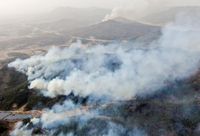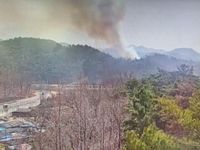The Korea Forest Service issued a nationwide crisis alert for forest fires at a 'Serious' level on March 25, 2025, as the effects of several large forest fires continue to threaten communities and the environment. This decision follows fires that erupted in Sancheong, Gyeongsangnam-do on March 21, and in Uiseong, Gyeongsangbuk-do and Ulsan, Ulju on March 22, which remain partially extinguished. The forest fire situation has worsened alarmingly, prompting officials to escalate the crisis alert for the entire country.
As of 4 PM on March 25, the Korea Forest Service has mandated that at least one-quarter of public officials and half of affiliated public service personnel must be deployed to manage the crisis effectively. This underscores the seriousness of the situation as officials scramble to contain the spread of fires while investigating their origins and preventing further outbreaks.
The escalating fire risk is amplified by the recent meteorological conditions. According to the agency, persistent dry and hot weather across the nation has led to a spike in wildfire occurrences. Forest Disaster Control Officer Lee Yong-kwon stated, "High-temperature and dry conditions have led to simultaneous wildfire outbreaks across the country, and strong winds heighten the risk of any small negligence transforming into a large-scale fire." Thus, fire officials are coordinating their efforts closely and mobilizing all available resources to combat these dangerous blazes.
Prior to elevating the national alert, on March 22, regions including Chungcheong, Honam, and Yeongnam were already escalated from a 'Caution' alert to 'Serious.' Meanwhile, other regions like Seoul, Incheon, Gyeonggi, Gangwon, and Jeju were raised from 'Caution' to 'Alert' status. The wide geographic spread of fire danger highlights the critical nature of the crisis affecting a vast swath of South Korea.
In the affected areas where the alert is now classified as 'Serious,' measures include restricting military training exercises within mountainous zones and suspending entry permissions to these regions. The government is taking all necessary precautions to mitigate the potential for further fire outbreaks and protect public safety.
Moreover, the effects of the ongoing Uiseong forest fire have been devastating, with the estimated damage area reported to be around 12,565 hectares. This makes it the third-largest forest fire damage recorded in South Korea, following two major incidents in 2000 and 2022. This alarming statistic illustrates the growing concern among environmental and emergency management officials regarding the management of forest fires in the country.
According to Lee, local governments are under strict orders to maintain readiness and cooperation amid this crisis. "We will maintain a close cooperative framework with local governments, fire departments, military, police, and weather institutes to protect forests and safeguard the lives and properties of citizens. We are committed to utilizing all available resources to extinguish the fires," he noted emphatically.
In addition to the immediate threats posed by the blazes, the Forest Service is focused on gathering comprehensive data regarding the fire incidents’ origins and the scope of existing damage. Home to complex ecosystems and diverse wildlife, the regions impacted by the fires are essential to South Korea's ecological balance. Without timely and effective intervention, these wildfires pose a significant threat to local flora and fauna.
As the crisis escalates, affected communities are urged to stay informed about the developing situation, adhere to government safety protocols, and report any potential fire hazards they encounter. The nationwide response to these fires highlights the governmental prioritization of public safety while reinforcing the need for community involvement in monitoring environmental risks.
As of now, the situation remains dynamic as new fire reports continue to emerge from various locations across the country, demonstrating the urgent need for vigilance and comprehensive firefighting strategies.
![[속보]산림청, 산불 재난 국가위기경보 '심각' 발령…전국 모든 지역](https://thumbor.evrimagaci.org/8WW0vl-Beoks4PtlUstyHkAk718=/200x0/tpg%2Fsources%2F27c264c7-ffb6-4f2b-91b8-16bce1ffb93a.jpeg)







